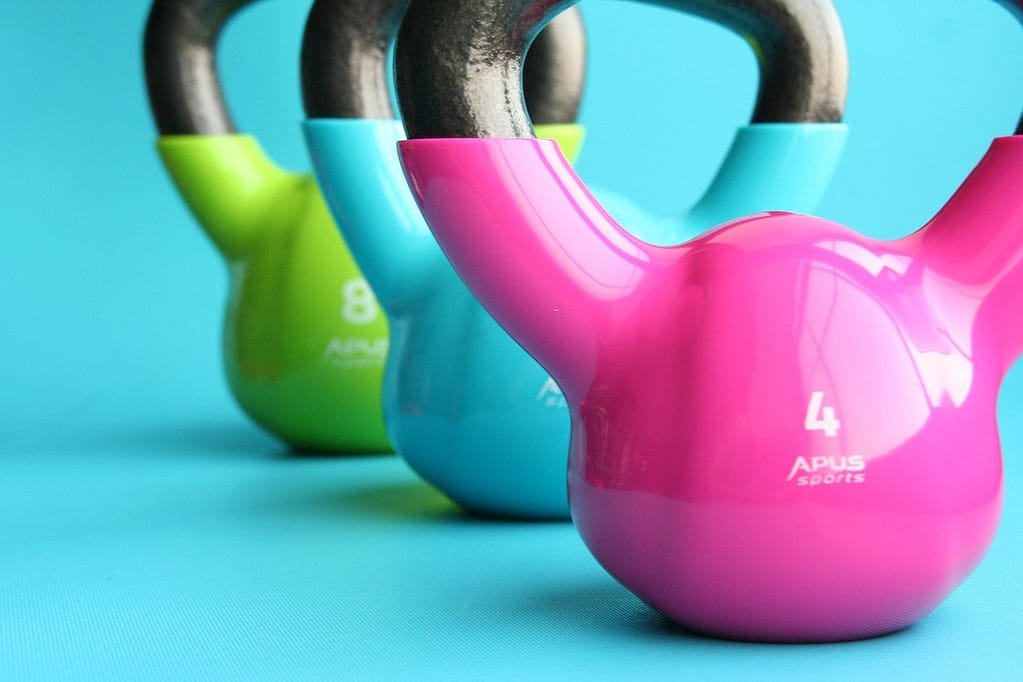Resistance training: to do or not to do, that is the question! Many middle aged and older women think that they have done all the exercise they needed to when they were younger, and now it’s time to rest. Some think that walking (maybe even a leisurely stroll) is plenty. Unfortunately that is not the case.
Aging does not just bring on some graying or thinning of hair, but it also leads to declines in our senses, our functional ability, as well as our becoming more frail, and becoming more susceptible to disease, especially chronic health conditions.
Table of Contents
What is Resistance Exercise?
Exercise in which you move your limbs against resistance provided by your own body weight, gravity, bands, bars or dumb bells.

Image by Joanna Dubaj from Pixabay
Benefits of Resistance Training
- Improves muscle strength and endurance
- Builds bone
- Balance and mobility
- Decreases risk of injury
- Weight management and maintenance
- Cardio respiratory fitness
- Decreased anxiety and depression
- Improved sleep
- Reduced mortality
- Improved cognition
- Increased habitual physical activity
- Increased self esteem
- Enhanced performance of everyday tasks/activities of daily living
In summary, engaging in regular resistance exercise improves our health, both physical and mental, our energy levels, and enables us to be independent and live fuller lives.
What does research have to say about some of the benefits of resistance training:
Effect on women’s metabolism
As women get into their 50s, they complain of a slowed metabolism which has resulted in increased body weight. Losing that excess weight becomes more and more difficult as well. One of the main reasons for this decreased metabolism, is the loss of muscle and bone mass as we age.
Muscle mass is more metabolically active than fat mass, hence, increasing lean mass or muscle, increases our metabolic rate, eventually causing more fat loss. The more fit you are, the more fat you will burn.
In a cross sectional study comparing female athletes and sedentary women ages 18-69, it was found there was no difference in the percentage of body fat and fat free mass, i.e., muscle and bone between the oldest and youngest women athletes. The BMR (basal metabolic rate) of the older athletic women was similar to the BMRs of the younger women, not that of the women of their own age group. Wow! So an older woman who is working out regularly, can have the metabolism of a youngster!
Hence the importance of building and maintaining lean mass throughout life with muscle and bone building exercise and diet. It’s never too late to start.
Effect on Metabolic Syndrome
Metabolic syndrome is a group of cardiovascular disease risk factors that occur together and increase one’s risk for cardiovascular disease and diabetes. Resistance exercise as well as aerobic exercise can both help prevent or manage metabolic syndrome. Resistance exercise performed at least 2 days per week can reduce the prevalence of Metabolic Syndrome and its individual components. (Churilla JR et al, Diabetes Metab Syndr., 2012)
Many studies have shown that Resistance Training improves blood sugar control more than aerobic exercise. (Bweir S et al, Diabetes Metab Syndr. 2009)
Resistance Training has been shown to reduce total cholesterol, low-density lipoprotein cholesterol (LDL-C) and triglycerides (Ibanez J et al, Obesity, 2010, Misra A et al, Diabetes Care, 2008).
Resistance Exercise has also been shown to help reduce blood pressure in people who had high blood pressure.(Melo CM, et al, Blood Pressure Monit, 2006)
Effect on Bone Health
Resistance Exercise not only builds muscle strength and mass, it also increases bone mass (bone mineral density and content) and the strength of the specific bones beings stressed, and can help prevent , slow down or even reverse the loss of bone mass in individuals with osteoporosis.
According to the American College of Sports Medicine (ACSM), Muscle weakness is a risk factor for developing osteoarthritis, making resistance training essential for reducing the development or progression of this disorder.
Resistance training can help reduce pain and disability in those affected by osteoarthritis.
If you were earlier doubtful of whether resistance training was necessary, I hope you are now convinced that it is essential for a variety of reasons. We want to age well, and resistance training helps us do that. It helps us remain stronger, fitter and more able to do what we want and need to and helps us prevent or better manage chronic health conditions.
If you are unsure of how to start resistance exercise to build muscle and bone, to reduce and manage your body weight or your chronic health conditions,
SCHEDULE A FREE CONSULTATION to find out if my programs are right for you.
I offer customized online programming.
If you know of someone who needs help, tag them or share this post with them.
For more information about exercising, check out my post:
Aerobic Exercise: For your heart’s sake
Benefits and risks of exercise
Exercise Recommendations: Are you doing enough?
How to exercise safely!
Sources:
ACSM’s Guidelines for Exercise Testing & Prescription
Resistance Training and Metabolic Syndrome: Muscles do matter (Sorace, P, Ronai P, Churilla, JR) ACSM’s Health & Fitness Journal, Nov/Dec 2014
Women, Exercise & Metabolism, Ruther, A, MS, Phd.
National Institute on Aging
https://www.betterhealth.vic.gov.au/health/HealthyLiving/resistance-training-health-benefits#health-benefits-of-resistance-training
No content on this site, regardless of date, should ever be used as a substitute for direct medical advice from your doctor or other qualified clinician.
I shared this post on:


Really enjoyed the guidance.
Thanks Rena. Do you participate in strength/resistance training?